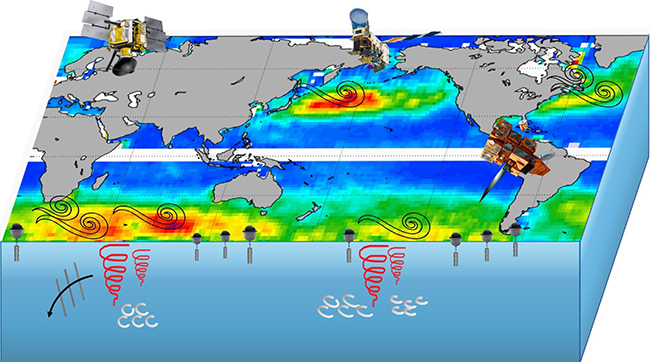物理海洋实验室研究成果被美国地球物理联合会(AGU)评为研究亮点
4月19日,物理海洋教育部重点实验室(以下简称实验室)主任吴立新院士的研究团队在国际知名学术期刊Geophysical Research Letters发表的题为《基于漂流浮标的全球风输入近惯性能量估计》(Wind Power on Oceanic Near-Inertial Oscillations in the Global Ocean Estimated From Surface Drifters)的研究成果被美国地球物理联合会(AGU)评选为研究亮点。AGU新闻发布网站Earth & Space Science News对该工作进行了报道。上述研究成果由实验室在读博士生刘永正为第一作者,实验室成员荆钊教授、吴立新院士为合著者共同完成。
风生近惯性能量是指以近惯性频率扰动的风可以引起海洋表层的共振,进而产生海洋表层的近惯性震荡。在风生近惯性能量向海洋内部传播的过程中,能量将向小尺度串级,最终导致波动的破碎,驱动跨等密度面湍流混合。在过去20年的研究中,基于数值模式结果估算的全球风生近惯性能量为0.3-1.5TW。模式对近惯性运动模拟的不确定性导致风生近惯性能量存在较大的变化范围,这影响了人们对海洋混合和能量耗散过程的模拟与研究。
实验室该亮点工作首次依靠观测结果对全球风生近惯性能量进行了估计。研究基于全球漂流浮标获得的流场数据和卫星获取的风场数据,计算出全球风生近惯性能量的气候平均态为0.3-0.6 TW,能量输入集中在中纬度海域(30°-60°),并在风暴活动剧烈的季节达到最强。
该项研究得到的全球风输入近惯性能量小于前人估算的量值,其主要原因是前人在计算风应力时忽略了海洋表层流速的影响,这将使风对海洋的能量输入被过高估计。此次我们的研究结果更加精确了风在近惯性频段对海洋运动的能量贡献,将显著提高对深海大洋跨等密度面混合过程能量来源的认识,并对评估模式的模拟能力、开发合理的能量耗散及混合的参数化方案具有重要意义。

图:风生近惯性能量示意图
新闻链接:https://eos.org/research-spotlights/numerical-models-overestimate-near-inertial-wind
文章基本信息:
Title: Wind Power on Oceanic Near-inertial Oscillations in the Global Ocean Estimated from Surface Drifters
Authors: LIU Y. -Z., Z. Jing, and L. -X. Wu
Journal: Geophysical Research Letters, 46, 2647-2653. https://doi.org/10.1029/ 2018GL081712.
Abstract: Wind power on oceanic near-inertial oscillations is thought to play an important role in furnishing the diapycnal mixing in the ocean. Yet their global distribution and magnitude have not been quantified based on observations. In this study, we use hourly ocean current records derived from surface drifters to compute the global near‐inertial wind power during 1993–2016, with a combination of surface wind measurements obtained from satellites. The climatological near‐inertial wind power integrated between 60°S and 60°N is estimated to be 0.3–0.6 TW. The strongest energy flux occurs in the 30–60° latitude band during the winter season as a result of energetic storm activities. Ocean current imprint on wind stress has a significant impact on the estimated global near‐inertial wind power from drifters. Neglecting this imprint overestimates the near‐inertial wind power locally by 25–120% and its global mean value by 60%.